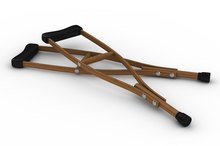How to Use a Patellar Tendonitis Strap
The patellar tendon encases the kneecap (patella) and connects the quadriceps muscles on the front of the thigh with the top of the shinbone (tibia). The pressure of a patellar tendon strap reduces the tendon’s cross section so that less pressure is applied to it. The pressure also counters inflammation at its insertion point on the tibia. Further, some distributors claim that patellar bands counter mistracking and jarring of the patellar tendon. (Mistracking is the leading cause of patellar tendonitis. 1) Pattelar tendonitis bands also go by the name “jumper’s knee strap,” “knee band” and “cho-pat knee strap.”
If you are experiencing serious medical symptoms, seek emergency treatment immediately.
Wear the band below the kneecap. Ensure that the strap is distal to (far from) the kneecap; it should be above the lowest point of the tendon. With a dual-action cho-pat strap, the larger of the two bands wraps around the leg above the kneecap.
5 Ways to Treat Haglund's Syndrome
Learn More
Keep the silicone-gel or rubber-tube portion of the strap over the tendon. Center the flat portion on the back of the leg. Keep the buckle on the side of the leg in order to avoid pinching the back of the knee or the tendon in front.
Wear it throughout the day when exerting the knee, not just for exercise. Injured patellar tendons suffer damage throughout the day, particularly from the eccentric contractions of walking, and can therefore benefit from the support.
Tips
To keep the strap from falling, the strap should be tight enough to be held up by the calf muscle below. It should not be made so tight that circulation is cut off; however, some distributors claim that it cannot restrict circulation. Shaving the skin underneath or purchasing a strap with some rubber on the underside can help adhesion. Look at the resource links below for photos that demonstrate how to wear the strap.
Warnings
Do not wear a knee band to bed. Do not wear one if a varicose vein crosses the knee. The risk is of cutting off circulation or forming a clot.
Related Articles
References
- PhysioRoom: Patella Tendonitis in Depth
- Reinking MF. Current concepts in the treatment of patellar tendinopathy. Int J Sports Phys Ther. 2016;11(6):854–866.
- Cleveland Clinic. Patellar tendonitis.
- Brockmeyer M, Haupert A, Kohn D, Lorbach O. Surgical technique: jumper's knee-arthroscopic treatment of chronic tendinosis of the patellar tendon. Arthrosc Tech. 2016;5(6):e1419-e1424. doi:10.1016/j.eats.2016.08.010
- Michener LA, Kulig K. Not all tendons are created equal: implications for differing treatment approaches. J Orthop Sports Phys Ther. 2015;45(11):829-832. doi:10.2519/jospt.2015.0114
- Unlu MC, Kivrak A, Kayaalp ME, Birsel O, Akgun I. Peritendinous injection of platelet-rich plasma to treat tendinopathy: A retrospective review. Acta Orthop Traumatol Turc. 2017;51(6):482–487. doi:10.1016/j.aott.2017.10.003
Tips
- To keep the strap from falling, the strap should be tight enough to be held up by the calf muscle below. It should not be made so tight that circulation is cut off; however, some distributors claim that it cannot restrict circulation. Shaving the skin underneath or purchasing a strap with some rubber on the underside can help adhesion. Look at the resource links below for photos that demonstrate how to wear the strap.
Warnings
- Do not wear a knee band to bed. Do not wear one if a varicose vein crosses the knee. The risk is of cutting off circulation or forming a clot.
Writer Bio
Paul Dohrman's academic background is in physics and economics. He has professional experience as an educator, mortgage consultant, and casualty actuary. His interests include development economics, technology-based charities, and angel investing.







